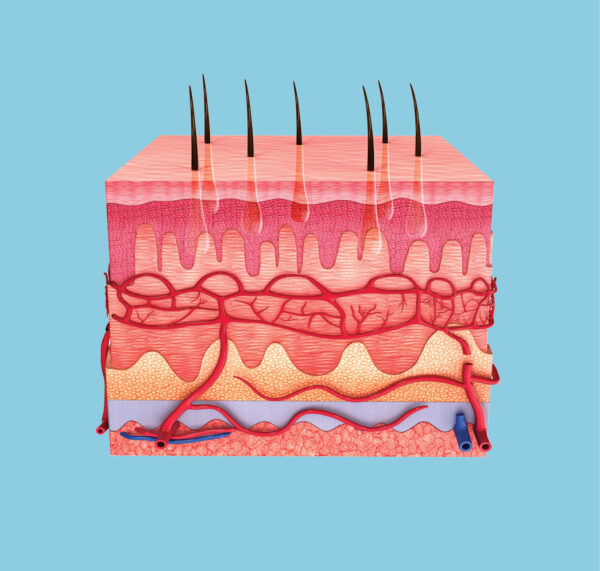Photo: Deagreez/iStock/Getty Images Plus
There’s more to skin than meets the eye. Dermatologist Deborah S. Sarnoff, MD, president of The Skin Cancer Foundation, sheds light on the weird and wonderful things that your skin can do, from renewing itself to repairing some of the damage that can lead to skin cancer.
To better understand the ins and outs of how skin works, it helps to know what’s happening in each of its three main layers (with help from the illustration, below). What you see on the surface is the epidermis, which acts like a waterproof barrier, keeping moisture locked in and bacteria, fungi, viruses, allergens and irritants out. It’s also home to squamous cells, basal cells and melanocytes, the latter of which produces melanin, the substance that gives color to skin and hair. DNA damage in any of these cells can lead to skin cancer.
The next layer of skin, the dermis, contains sweat and oil glands, hair follicles, blood vessels and lymph vessels, which carry out waste. Cells in this layer produce collagen and elastin fibers, which give skin structure and allow it to stretch.
The bottom layer is the hypodermis, aka the subcutaneous fat layer, which means fat stored under the skin. (Some experts don’t even consider this layer part of the skin.) The fat, which attaches to bone and muscle, helps cushion and insulate the body. The blood vessels in the dermis extend into the hypodermis, getting larger so they can circulate blood throughout the body, deliver nutrients to other organs and transport waste. Now, onto the fun facts!

From top to bottom, you’re looking at the epidermis, the dermis and the hypodermis — the three main layers of skin. Credit: Getty Images
1. One little square inch of skin is made up of 19 million skin cells
Within that inch of skin, there are different types of skin cells, each with its own specific job. For example, that includes about 60,000 melanocytes, cells that produce melanin pigment, which gives skin its color. All humans have melanocytes (with the exception of some people who were born with albinism). The majority of skin cells are keratinocytes. These include basal and squamous cells, the two types from which the most common skin cancers can arise. According to the Cleveland Clinic, a square inch of skin also contains 300 sweat glands, 20 blood vessels and 1,000 nerve endings. And that’s just scratching the surface. The average adult has 2,800 square inches — about 22 square feet of skin!
2. Your skin sheds 30,000 skin cells a minute
You may not see the dead, dull skin flaking off your face and body, but it’s happening all day. It takes about a month for newly formed skin cells to make their way to the surface — a timeframe that decreases with age. “Cell turnover can take as much as six to eight weeks in someone in their 60s or 70s, and that buildup of dead skin cells can make their complexion appear duller and drier,” says Dr. Sarnoff. You can speed up the process (at any age) with topical products that contains retinoids, which promote new cell growth, or alpha hydroxy acids, including glycolic acid. These loosen up the intercellular glue-like substance that holds skin cells together on the surface, allowing them to slough off sooner. You can find these ingredients in cleansers, serums, lotions or creams.
3. Skin contains 11 miles of blood vessels
The road to healthy, radiant skin is paved with blood vessels. “These bring oxygen and nutrients to your cells, remove waste and help regulate your skin’s temperature,” says Dr. Sarnoff. When the skin gets warm, your blood vessels dilate, allowing heat to escape to the outside air. When it’s cold outside, they constrict, keeping the heat in your skin. When you come back inside for hot chocolate, the blood vessels dilate again, giving you that rosy flush.
4. Skin accounts for 10 to 15 percent of your body weight
Next time you’re feeling frustrated with the scale, remember that a lot goes into the number you see on the screen, including the weight of your skin. It’s the heaviest of all your organs. “That 10 to 15 percent is composed of water, oils, lipids (fats), nutrients, hair follicles, blood and lymph vessels, collagen and living and dead cells,” says Dr. Sarnoff. In the average adult, that can mean 20 pounds of skin alone — about the weight of Dr. Sarnoff’s dog, Maxie.
5. Skin has its own metabolism
You hear a lot about the body’s metabolism and how it slows with age, affecting everything from energy levels to the way your jeans fit. But did you know that your skin has a metabolism, too? The term refers to processes within the skin that control production and breakdown of collagen and elastin. It also affects how well your skin renews its cells, repairs its damage and even how it responds to topical products you use. Like your body’s metabolism, the skin’s metabolic processes also lag with age and exposure to environmental aggressors. A review in the Journal of Cosmetic Dermatology showed that ultraviolet (UV) radiation causes changes in cellular metabolism, leading to visible signs of photoaging.
6. Your skin is on the clock
You’re not the only one who runs on a 24-hour cycle. Researchers have discovered that your skin has a circadian (Latin for “about a day”) rhythm, governed by the suprachiasmatic nucleus (SCN) of the brain. That’s a mouthful, but it’s basically a group of nerve cells that act as a master clock. During the daylight hours, your skin is in protective mode, trying to shield your cells from UV light, free radicals, pollution, etc. At night, skin’s repair processes kick into high gear, with research showing that repair peaks at night. The circadian rhythm also influences skin temperature and permeability. Both increase at night, making skin more receptive to topical ingredients. The circadian rhythm also increases transepidermal water loss (TEWL) at night, the process by which water escapes from the skin. So, before bed, it’s prime time to apply moisturizer.
Research has also shown that the body’s nucleotide excision repair (NER) system, responsible for removing UV photodamage from DNA, is controlled by the skin’s circadian rhythm. If this system doesn’t remove the damaged DNA, these mutations may cause skin cancer. According to a recent review in the International Journal of Molecular Sciences, circadian rhythm disruption may be linked to the disease, with the newer research focusing on manipulating circadian clock functions and so-called clock genes within the skin to reduce skin cancer risk. Bottom line: Get your beauty sleep at night and wear sunscreen during the day.
7. Your skin can flex
You know that your skin covers your muscles, but did you know there are teeny-tiny muscles within the skin, too? They’re called the arrector pili muscles, and they’re located inside your hair follicles. Fun fact: “It’s these little muscles that make your hairs stand straight up when you get goosebumps,” says Dr. Sarnoff.
8. Skin is an “emotional” organ
You may have assumed your brain holds that title, but your skin is the most sensory of all the organs, says Dr. Sarnoff. It reacts to temperature, pressure, vibration, pain and pleasure. “The dermis contains cells with nerve fibers that transmit sensations of touch to the brain,” she says. Skin is also highly reactive to emotional stress. Research has shown that inflammatory skin issues such as eczema, psoriasis and acne often flare during stressful times. And stressful situations can also trigger sweating, itching and hives. Experts have found the connection between stress and skin is bidirectional. Simply put, stress can exacerbate skin issues, but skin can also send signals to the brain, triggering a stress response.
9. The barrier is skin’s unsung hero
Sunscreen keeps skin’s surface safe from sunburns, and its cells protected from UV damage. Your barrier, the outermost layer, plays a crucial role in protecting skin, too. Its job is to keep potential irritants, allergens and bacteria out of skin, and moisture locked inside. Even large molecules in some antiaging skin-care products can’t pass through skin’s barrier, despite what cosmetic brands claim. “The molecules in most cosmetic compounds are too large to be absorbed, so don’t believe everything you hear about absorption,” says Dr. Sarnoff. When the skin’s barrier gets damaged (from UV exposure, harsh cleansers, over-exfoliating, etc.), microscopic tears form. This allows water to escape and gives potential irritants a fast pass into your skin, making it feel dry and sensitive.
10. Skin has a microbiome
You’ve likely heard some buzz about the gut microbiome, a community of microbes that live in your intestines and may influence everything from immune health to how a person will respond to drug treatments, including immunotherapy for melanoma. Well, the skin has a microbiome, too, with trillions of microorganisms such as bacteria, viruses and fungi that play a role in fighting infection, controlling inflammation and even helping your immune system recognize possible threats. Researchers are working on treatments to manipulate the bacteria on the skin’s surface to treat inflammatory skin conditions such as atopic dermatitis, acne and diseases including skin cancer.




